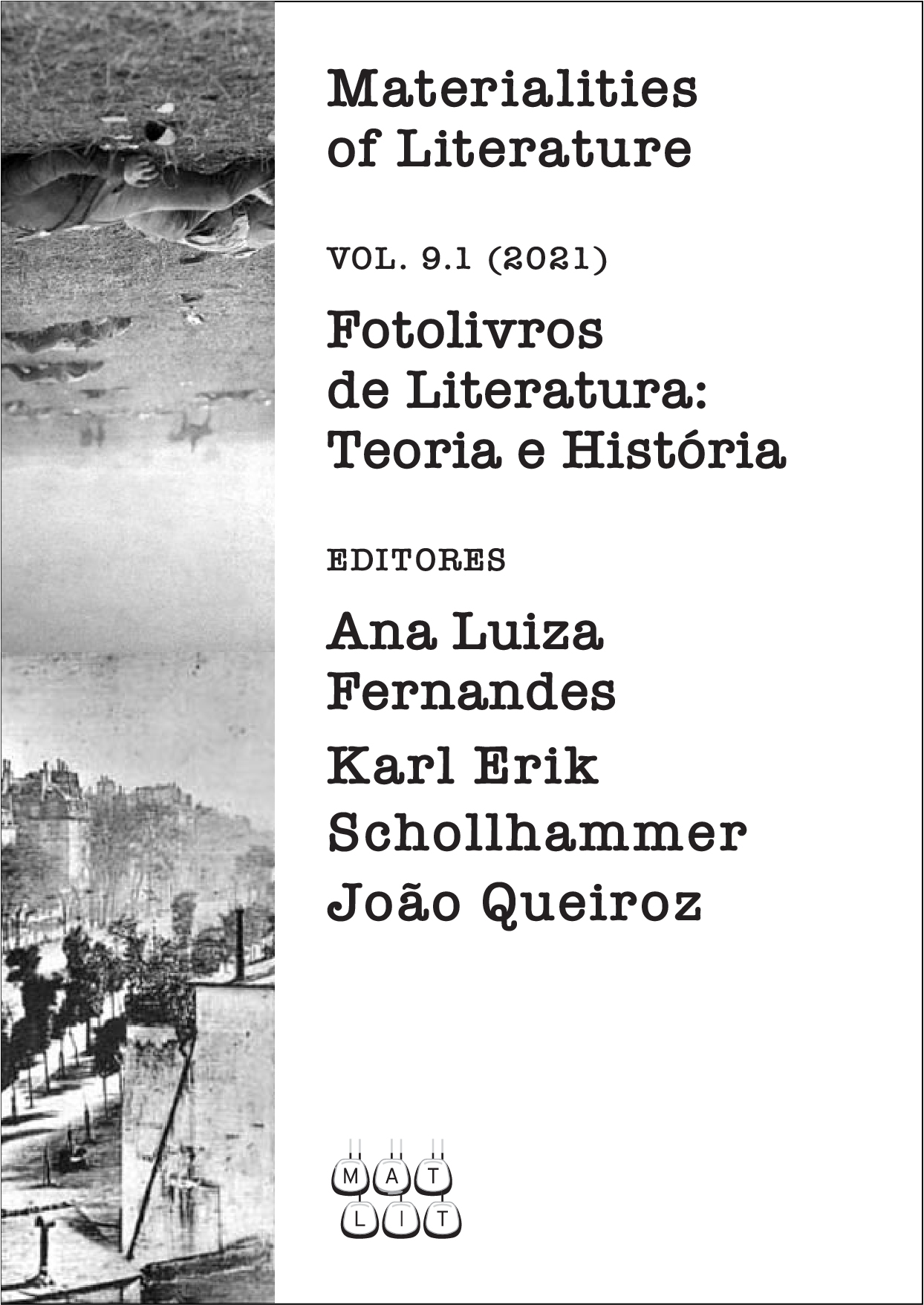Signatures of gazes: an analysis of the photobiography of José Cardoso Pires
DOI:
https://doi.org/10.14195/2182-8830_9-1_4Keywords:
photobook, photobiography, image, argument, José Cardoso PiresAbstract
The present article aims to analyse hypotheses for reading and understanding a photobook from a specific case: the photobiography. To do so, we take as object of study the photobiography of the writer José Cardoso Pires by Inês Pedrosa, published one year after the author's death. In a predominantly visual genre, we intend to explore the concept of narrativity, commonly associated with the structure of verbal texts. Furthermore, we look into the relations between text and image, within the photobiography, for the production of a third genre: the essay, which is inserted in the work through the text-montage O cirurgião das palavras, also by Inês Pedrosa. Thus, the photobiography is analysed from symbolic, narrative, and rhetorical perspectives.
Downloads
References
ADORNO, Theodor W. (2003). “O ensaio como forma”. Notas de Literatura I. Trad. Jorge M. B. de Almeida. São Paulo: Duas Cidades/ Editora 34.
ANDRADE, Carlos Drummond de (1942). Poesias. São Paulo: Livraria José Olympio Editora.
BARILLI, Renato (1994). Curso de estética. Trad. Isabel Teresa Santos. Lisboa: Editorial Estampa.
BARTHES, Roland (2007). A câmara clara. Lisboa: Edições 70.
BOURDIEU, Pierre (1996). Razões Práticas: sobre a teoria da ação. Trad. Mariza Corrêa. Campinas: Papirus.
BRUNO, Fabiana (2010). “Fotobiografia: por uma metodologia da estética em antropologia”. Resgate: Revista Interdisciplinar de Cultura, 18.2: 27-45. DOI: 10.20396/resgate.v18i19.8645677.
CASSIRER, Ernst (2004). Filosofia das formas simbólicas. São Paulo: Martins Fontes.
CASSIRER, Ernst (1972). Antropologia filosófica: ensaio sobre o homem – introdução a uma filosofia da cultura humana. Trad. Vicente Félix de Queiroz. São Paulo: Editora Mestre Jou.
COLBERG, Jorg (2017). Understanding Photobooks: the Form and Content of the Photographic Book. Londres: Focal.
COSTA, Ana Paula (2020). Fotolivro como montagem: fenômenos de justaposição eisensteiniana, tese de doutoramento apresentada ao Departamento de Letras da Pontifícia Universidade Católica do Rio de Janeiro. 16 jun 2020. http://www.dbd.puc-rio.br/pergamum/tesesabertas/1612456_2020_completo.pdf. [12 junho 2021].
DELEUZE, Gilles, e Félix Guattari (1995-1997). Mil Platôs. Capitalismo e Esquizofrenia. Rio de Janeiro: Editora 34.
GUMBRECHT, Hans Ulrich (2009). “A presença realizada na linguagem: com atenção especial para a presença do passado”. História da Historiografia: International Journal of Theory and History of Historiography, 2.3: 10-22. Trad. Bruno Diniz, Juliana Jardim de Oliveira e Oliveira, Valdei Araújo. DOI: https://doi.org/10.15848/hh.v0i3.68.
GUMBRECHT, Hans Ulrich (2011). Our Broad Present: time and contemporary culture. Nova Iorque: Columbia University Press.
LANGER, Susanne (2004). Filosofia em nova chave. São Paulo: Perspetiva.
LANGER, Susanne (1980), Sentimento e forma. São Paulo: Perspetiva.
MAZZILLI, Bruna (2020). O fotolivro como espaço de complexidade e potência para a fotografia documental, tese de mestrado apresentada à Escola de Comunicação e Artes da Universidade de São Paulo. 2020. https://www.teses.usp.br/teses/disponiveis/27/27164/tde-03032021-164516/publico/BrunaSanjarMazzilli.pdf [12 junho 2021].
MORA, Gilles, e Claude Nori (1983). L’été dernier: manifeste photobiografique. Paris: Éditions de l’Étoile.
PARR, Martin, e Gerry Badger (2004). The Photobook: a history, v. 1. Londres: Phaidon.
PEDROSA, Inês (1999). José Cardoso Pires: Fotobiografia. Lisboa: Publicações Dom Quixote.
PEDROSA, Inês (2009). Nas tuas mãos. Lisboa: Publicações Dom Quixote.
PIRES, José Cardoso (2003). E agora, José?. Porto: Círculo de Leitores.
PIRES, José Cardoso (1968). O Delfim. Lisboa: Livraria Moraes.
PREVEDELLO, Tatiana (2018). “Sob o signo de Chronos e Kairós: a narração do tempo em Lobo Antunes”. Revista de Estudos Literários 8: 275-300. Coimbra: Imprensa da Universidade de Coimbra. DOI: https://doi.org/10.14195/2183-847X_8_11.
RAMOS, Marina (2017). Conhecer Fotolivros: (in) definições, histórias e processos de produção, tese de mestrado apresentada ao Centro de artes e Comunicação integrado no Departamento de Comunicação Social da Universidade Federal de Pernambuco. 25 out 2017. https://repositorio.ufpe.br/handle/123456789/28352 [19 março 2021].
REIS, Carlos (2018). Dicionário de Estudos Narrativos. Coimbra: Almedina.
ROSADO, Sofia (2009). “Biografia”. E-dicionário de termos literários. 24 dez 2009. https://edtl.fcsh.unl.pt/encyclopedia/biografia/ [19 março 2021].
ROUILLÉ, André (2009). A fotografia: entre documento e arte contemporânea. São Paulo: Senac.
Published
How to Cite
Issue
Section
License
Copyright (c) 2021 Gabriella Campos Mendes, Rita Cristina Gomes

This work is licensed under a Creative Commons Attribution 4.0 International License.
MATLIT embraces full open access to all issues. Authors who publish with this journal agree to the following terms:
- Authors retain copyright and grant the journal right of first publication with the work simultaneously licensed under a Creative Commons Attribution- 4.0 International (CC BY 4.0) that allows others to share the work with an acknowledgement of the work's authorship and initial publication in this journal.
- Authors are able to enter into separate, additional contractual arrangements for the non-exclusive distribution of the journal's published version of the work (e.g., post it to an institutional repository or publish it in a book), with an acknowledgement of its initial publication in this journal.
- Authors are permitted and encouraged to post their work online (e.g., in institutional repositories or on their website) prior to and during the submission process, as it can lead to productive exchanges, as well as earlier and greater citation of published work (See The Effect of Open Access).
- A CC licensing information in a machine-readable format is embedded in all articles published by MATLIT.
- Attribution — You must give appropriate credit, provide a link to the license, and indicate if changes were made. You may do so in any reasonable manner, but not in any way that suggests the licensor endorses you or your use.
- No additional restrictions — You may not apply legal terms or technological measures that legally restrict others from doing anything the license permits.
Notices:
- You do not have to comply with the license for elements of the material in the public domain or where your use is permitted by an applicable exception or limitation.
- No warranties are given. The license may not give you all of the permissions necessary for your intended use. For example, other rights such as publicity, privacy, or moral rights may limit how you use the material.




